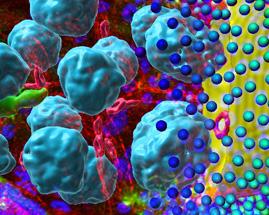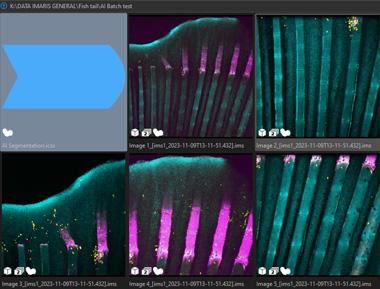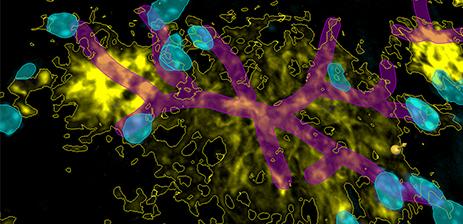Hardware Solutions
Applications
Optimize your image analysis workflows using AI trainable object detection in Imaris 10.1. Imaris AI pixel classifier is unique, featuring:
Imaris AI image analysis workflow (pixel classification and object classification) used for quantitative analysis of organoids. Video courtesy of A. Boyreau, CNRS and L. Andrique VoxCell Facility, TBMcore
Imaris AI segmentation helps to segment and visualize greyscale images, such as CT or MRI. Video based on private data.

Imaris 10.1 AI segmentation workflows for precise segmentation of cellular structures.
Automated segmentation of some SEM images can be largely improved using AI image segmentation in Imaris. Video courtesy of R. Schekman & A. Gorur, University of California

One of the things you may want to do is to apply the same classifier to multiple images and to train it on several images. Both are possible. When you store Surfaces creation parameters the classifier is stored with those creation parameters and the training data are stored with the creation parameters.
The stored creation parameters can be used to run batch processing. The stored creation parameters can also be opened on a new image to continue training on that new image.
Have you tried Imaris object visualization on extended sections slicers? The slicer visualization largely helps to set up and evaluate segmentation results in large and thick 3D datasets as well as select or classify interesting objects, which are otherwise occluded by other structures. If you have missed the possibility to visualize multiple objects (Spots, Filaments, Surfaces) on the same slicer to assess their interaction or overlap, you would love this feature in Imaris 10.1.

Imaris has a unique capability to render and visualize large 3D datasets (exceeding the computer RAM), enabling smooth rotation in all directions and zooming.
Nevertheless, not all the datasets are 3D – now Imaris perfectly renders your 2D and 2D time datasets on a single plane and offers accurate 2 D measurements.
The new AI Machine Learning Segmentation is very easy to use and very efficient on big 3D data. I was impressed by its speed and its implementation in the surface protocol, which allows very efficient filtering of the created objects. This implementation of the Machine learning workflow into Imaris is very appreciated.
Nicolas Goudin, Head of Necker Bioimage Analysis Platform – SFR Necker, Paris
The Imaris Learning Center hosts a wide range of tutorial videos, how-to articles and webinars to guide you through the many features of Imaris. We have provided some links below which will get you started on some of our most recent developments.